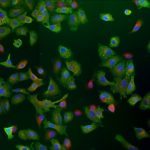Lien vers Pubmed [PMID] – 24945353
PLoS Pathog. 2014 Jun;10(6):e1004164
Influenza A viruses are major pathogens in humans and in animals, whose genome consists of eight single-stranded RNA segments of negative polarity. Viral mRNAs are synthesized by the viral RNA-dependent RNA polymerase in the nucleus of infected cells, in close association with the cellular transcriptional machinery. Two proteins essential for viral multiplication, the exportin NS2/NEP and the ion channel protein M2, are produced by splicing of the NS1 and M1 mRNAs, respectively. Here we identify two human spliceosomal factors, RED and SMU1, that control the expression of NS2/NEP and are required for efficient viral multiplication. We provide several lines of evidence that in infected cells, the hetero-trimeric viral polymerase recruits a complex formed by RED and SMU1 through interaction with its PB2 and PB1 subunits. We demonstrate that the splicing of the NS1 viral mRNA is specifically affected in cells depleted of RED or SMU1, leading to a decreased production of the spliced mRNA species NS2, and to a reduced NS2/NS1 protein ratio. In agreement with the exportin function of NS2, these defects impair the transport of newly synthesized viral ribonucleoproteins from the nucleus to the cytoplasm, and strongly reduce the production of infectious influenza virions. Overall, our results unravel a new mechanism of viral subversion of the cellular splicing machinery, by establishing that the human splicing factors RED and SMU1 act jointly as key regulators of influenza virus gene expression. In addition, our data point to a central role of the viral RNA polymerase in coupling transcription and alternative splicing of the viral mRNAs.



